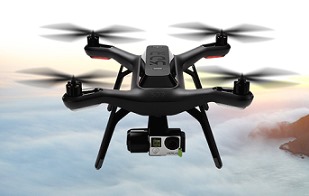http://diydrones.com/profiles/blogs/check-our-new-apm-2-0-revision-the-apm-2-5
I’m pleased to announce the new APM 2.0 revision, better known as APM2.5!
But before you start screaming that you just got an APM 2.0, let me explain that there’s NO difference in performance at all between the two, the board is still the same in terms of functionally and it runs exactly the same code as APM 2.0. We just took the liberty of throwing in a few new universal connectors in there (so accessories can be cross compatible with the new PX4 and protect the user from connecting the cable in the wrong direction), some production improvements that will allows to manufacture it faster and finally we added some protection features to protect it from those reverse polarity/short circuit lovers.
Here goes the full list of changes (you already know all its features):
1. No more shield/daughterboard: magnetometer and dataflash were moved to the main board, making it easier to assemble, repair and hack.
2. No more on-board GPS, but we added a new 6-pins DF13 connector for our new GPS cable standard (PX4) and kept the old but reliable Molex (EM-406) connector for old GPS compatibility.
3. The old radio-modem connector is gone and now is being replaced by our new 6-pins DF13 connector (like the GPS, because both are UART’s. Got it?), this will make it compatible with PX4 and prevents users from blowing up the UART mux.
4. We added a second protection fuse and diode (you are no longer required to solder it yourself) for extra reverse polarity and short circuit protection.
5. The old I2C connector is gone and has been replaced by our new 4-pins DF13 connector (yeah PX4 compatible. Oh wait correction… None of both (PX4 & APM2.5) are compatible with each other, we created this standard together as a team, but I have to give the average of the credits to PX4).
6. Added a “mystery” 6-pin DF13 Connector that will be used later. I know you like surprises so please stay tuned. No big deal but is really cool and will save you some soldering here and there.
7. Added “Magnetometer Jumper” that allows you to disable the on-board magnetometer, so you can attach an external one.
8. Added extra LED attached to the PPM encoder (Atmega32-U2) on pin PC7. This will allows us later to use it as PPM status indication and leave those poor TX/RX LED’s do their intended job.

Those who ordered the APM2.0 and are still waiting for it (only if is not shipped yet) will have the option to upgrade to the new APM2.5, but you will be required to wait an extra couple of weeks for production to begin. For upgrades please send us an email to sales@3drobotics.com.
If you want to order one now you can get the assembled version here and the unassembled version here (for those who want their choice of RC connector: straight or right-angled). They will begin shipping in a week or so, but if there is a huge flood of orders, the backlog for any individual order may grow to 2-4 weeks. We're making them at the new Tijuana facility, so we hope that we'll be able to keep up with demand much better than we have in the past. We're committed to shrinking all delays, and our investment in the Tijuana facility is just one sign of this.
The APM 2.0 enclosures will not fit this new board, so new enclosures are on their way. If you buy an APM 2.5 now, you will get a $4.99 credit for a free enclosure with your next order (the enclosures should be in in about a month). Also, APM 2.5 will ship with an adapter cable for the 3DR/Xbee radios, converting from the APM 2.5 DF13 connector to the radios' conventional 6-pin connectors. Eagle files for the boards will be posted in the next few days.










